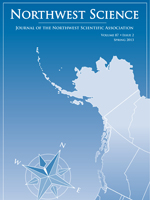Changing seasonal soil moisture regimes caused by global warming may alter plant community composition in sensitive or endangered habitats such as wetlands and oak savannas. To evaluate such changes, an understanding of typical seasonal soil moisture regimes is necessary. The primary objective of this study was to document seasonal soil moisture patterns in herbaceous plant communities across a range of soils typical of Willamette Valley wet prairie, floodplain, and oak savanna habitats. Volumetric soil moisture data were collected periodically from January 2010 through December 2011 at study sites using time domain reflectometry and converted to plant-available soil moisture using moisture release data for each of the soils. In addition, plant communities, soil texture, and soil chemical attributes were evaluated at all sites. Both 2010 and 2011 experienced unusually high spring rainfall, and soils did not begin dry down until about the third week in June. The length of the dry period was similar in both years, but in 2011 it was shifted from mid-July through early September to early August through early October. Well-drained floodplain soils consistently had the lowest soil moisture contents in both years. Wet prairie sites began to dry down shortly after oak savanna sites, and their rates and severity of dry down were similar. These results suggest that the composition of herbaceous plant communities in wet prairie habitats may be influenced more by winter and spring inundation than by summer drought and that the timing of rainfall events during the dry period could influence plant community composition.
How to translate text using browser tools
1 May 2013
Seasonal Soil Moisture Patterns in Contrasting Habitats in the Willamette Valley, Oregon
Michael A. Bollman,
George A. King,
Lidia S. Watrud,
Mark G. Johnson
ACCESS THE FULL ARTICLE

Northwest Science
Vol. 87 • No. 2
May 2013
Vol. 87 • No. 2
May 2013
climate change
oak savanna
plant community
wet prairie




